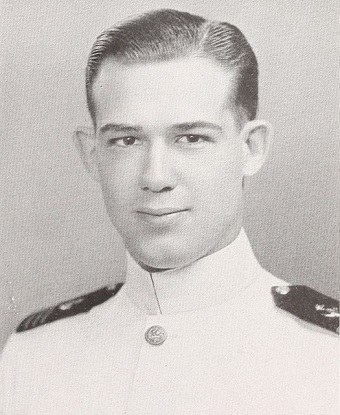Last updated: January 17, 2025
Person
Alfred Brunson Wallace

Alfred Brunson Wallace, alongside his brother Thomas, dedicated his life to serving in the US Navy.
Born March 2, 1916, Wallace grew up with his brother in Gulfport, Mississippi. He graduated from high school and completed one year at Georgetown University. In June 1935, the Naval Academy accepted Wallace's enrollment as a midshipman. While at the Academy, he completed his normal duties and studies, as well as dedicated time to his hobbies of boxing and playing football. He came to be known as "Mike" to his fellow midshipmen and graduated with the class of 1939. Now Ensign Wallace, he reported to USS Tennessee (BB-43) June 24, 1939, and was detached May 27, 1940.
In August, 1940, Ensign Wallace headed to Washington to join USS Charles F. Hughes (DD-428), the first of five destroyers on which Wallace served. Fitting out was underway in the Navy Yard of Puget Sound, Washington. With the commissioning of the ship on September 5, 1940, Wallace became a plank owner (Navy jargon for a member of the original crew).1 As its first assignment, Charles F. Hughes traveled through the Panama Canal and conducted training exercises in the Caribbean. Then the destroyer reported for convoy duty in the Atlantic, with a home port in Newport, Rhode Island. Once the United States joined the Allies to fight in World War II, troop transports were added to the convoys. On two occasions the crew picked up survivors from sunken ships; including Red Cross nurses.2 During the two years Wallace served on Charles F. Hughes, he earned much experience and three promotions. On June 1, 1941, he married Jeanne Mary Gifford, of Portland, Maine.
Lieutenant (T) Wallace reported November 30, 1942, to USS Hilary Herbert (DD-160) as the Executive Officer. The ship was old (commissioned in 1919) but overhauled and updated in 1940. Herbert served as a convoy escort during the Battle of the Atlantic, protecting merchant ships from German submarines while they carried stores of war supplies to our allies in Britain. The range of escorts spanned from Key West to Halifax, Canada, and as far north as Iceland.3 Boston, Massachusetts served as the home port for Hilary Herbert.4 Wallace detached April 23, 1943, shortly after being commissioned as a regular lieutenant.
In May of 1943, Lieutenant Wallace went to Orange, Texas, where the Consolidated Steel Corportion was building USS Lucien Young (DD-580). As a member of the crew prior to the ship's commissioning July 31, 1943, Wallace once again Wallace was a plank owner in addition to holding the post of Executive Officer. Charleston, South Carolina served as the home for the Lucien Young until December 1943, when it became part of the Pacific Fleet. In March of 1944, Wallace detached from the ship, attended training, and was promoted to lieutenant commander (temporary) (Lt. Cmdr (T)).
In the fall, Lt. Commander Wallace reported to USS Gwin (DD-772) which was being fitted out in Bethlehem Steel Co., in San Pedro, California. Again, he was a plank owner and the new ship’s Executive Officer. He served on Gwin from September 30, 1944 to July 2, 1945. (After the war, the Navy sent his wife Jeanne the Navy Unit Commendation earned by USS Gwin.)5 On Independence Day 1945 Lt. Comdr. (T) Alfred Wallace started training to become a commanding officer of his own ship. In a letter of endorsement A. M. Townsend, Commander Mine Squadron Three, wrote:
…Lieutenant Commander A. B. Wallace has been under my close observation. His performance of duty as navigator and chief evaluator in the Combat Information Center has left nothing to be desired. He has been of unestimable value to me as Staff Navigator.6
Lieutenant Commander (T) Wallace reported aboard USS Cassin Young (DD-793) July 27, 1945. He was to shadow Commander John W. Ailes for a short period before taking command of the ship for the first time. Three days later, a kamikaze struck Cassin Young. The ship was on picket duty off the coast of Okinawa when multiple planes attacked the ship. One plane crashed through the main deck just behind the forward smokestack causing the boilers in the forward fireroom below to explode. Wallace never got to take command of his own ship; he was killed by shrapnel fragments. In a coincidence made possible by wartime circumstances, his widow, Jeanne, married his best friend from the Academy after the war.
In 1949 Lt. Cmdr. Wallace was buried in Evergreen Cemetery in Gulfport, Mississippi, in the plot where his parents would later be interred. In 1994 his brother Lt. Cmdr. Thomas Lyon Wallace was buried in Biloxi National Cemetery about 10 miles east.
Footnotes:
- Official Military Personnel File of Alfred Brunson Wallace, National Personnel Records Center, National Archives and Records Administration, St. Louis, MO.
- "Haze Gray and Underway," accessed July 2020, hazegray.org, and The Tin Can Sailor (July 1997)
- Naval History and Heritage Command, (February 2016)
- Official Military Personnel File of Alfred Brunson Wallace, National Personnel Records Center, National Archives and Records Administration, St. Louis, MO.
- Ibid.
- Ibid.
